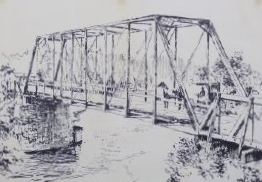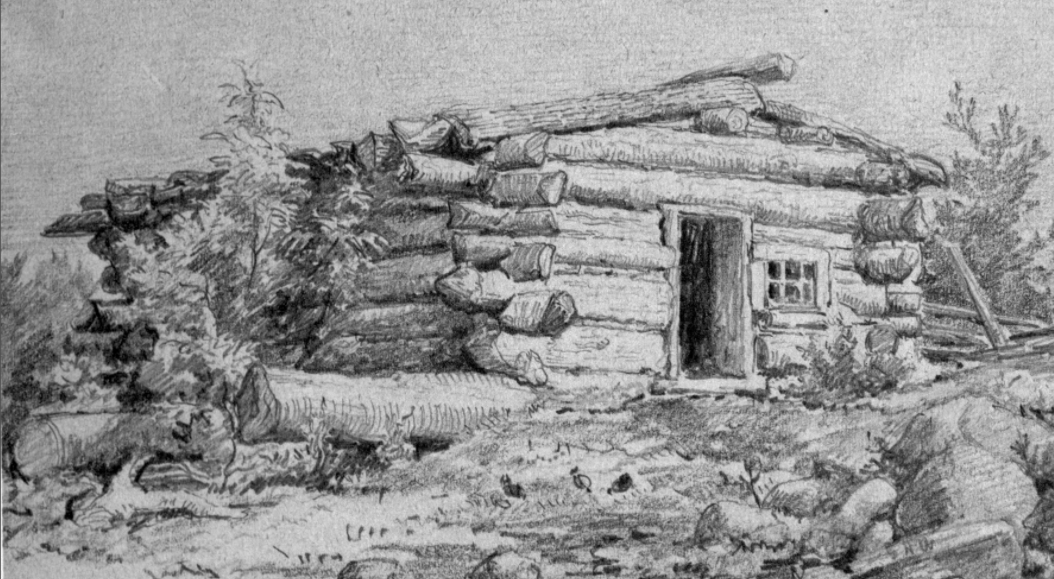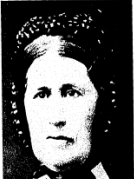If you’re out touring County Roads this summer, you may notice some new brown and white heritage signs marking Huron County’s historic settlements. The project was initiated by the County’s Public Works Department as a way to remember these communities that once existed in Huron. To date, 23 signs have been erected, including three signs marking communities that still exist, but under a different name. These signs have the word ‘historic’ added to show their historic name, like Manchester, which is still a thriving community now known today as Auburn.This summer, our student Maddy Gilbert will explore the history of some of these settlements.
The Village of Manchester was founded in 1854 on the edge of the Maitland River where the Village of Auburn now sits. It was listed on a map from the 1860s as Manchester, but by 1879, a map of Huron County lists the village as both Manchester and Auburn. As recent as 1979, the official name for the community was the Police Village of Manchester, while Auburn was the name of the post office. But by February 1979, Manchester was no more as the village trustees voted to keep Auburn as the one and only name for the village. Since there was another Manchester located in Ontario, the change came to avoid confusion between the two communities.
Eneas Elkin was the first settler to Manchester. He walked all the way from the City of Hamilton and built a log shanty. George Elkin, son of Eneas and Isabel Elkin, was the first baby born in Manchester on April 13, 1850. The first wedding in the village was credited to be between Anne (nee McDonald) and Joseph Tewsley. Annie passed away after only one year.
For the first two years after Mrs. Elkin joined her husband Eneas in Manchester, there was only a track between Goderich and Manchester, until the Canada Company opened what is now Huron County Road #25 in 1851. Until a bridge was built, Elkin ran a ferry across the Maitland River. The first two bridges crossing the Maitland were constructed out of wood and washed away in spring floods. The third bridge was constructed partly out of steel, until the concrete bridge was constructed a few yards upstream in 1954.
Eneas Elkin surveyed Hullett Township, which was amalgamated into the Municipality of Central Huron in 2001.

1975 Ink Print of the Auburn Bridge done by Jim Marlatt, a local artist. This bridge was in use until the new, concrete bridge was completed upstream in 1954.
By 1866, Manchester had a flour mill which shipped goods as far as Montreal. There was also a saw mill erected by John Cullis after he purchased the flour mill. The saw mill produced lumber from the logs that were cleared, to be sold as lumber for the barns being erected throughout the area. Cullis’ saw mill was destroyed by fire in 1893, and Cullis rebuilt a short distance away. The second mill was also victim to fire.
The Village had power by 1896 leading to the installation of electric powered street lamps. A.E. Cullis, who ran the grist mill, installed a direct current generator on his property and supplied power from dusk until 11 p.m. at the rate of two cents per light per night. Most villagers kept their costs down by attaching one light to a very long cord that they could move from room to room.
The Auburn CPR Station opened in 1907 with the delivery of a car-load of salt to W.T. Riddell. One delivery was a cow from Bracebridge. The station closed in 1979 and any deliveries made by train for people living in the village would have been left at the Blyth CPR Station.
The first brick bank in Manchester was the Sterling Bank of Canada, which eventually became a CIBC branch. On Nov. 14, 1930, Manchester suffered a terrible fire, which destroyed the hardware store that was located beside the bank. Mr. and Mrs. Carter were the first to notice the fire, and Mrs. Carter ran into the street yelling “fire!”. Mrs. Carter could have been the one who saved the lives of Mr. A.M. Rice and family, who resided above the CIBC, where Mr. Rice was manager.
Today, the Village of Auburn sits southeast of the intersection of Huron County Road 25 (Blyth Road) and Huron County Road 8 (Base Line). Auburn lies 20 km east from Goderich, 20 km north from Clinton, and 10 km west from Blyth.
Sources
Belden, H. “Map of Morris Township.” Illustrated Historical Atlas of the County of Huron, Ont., H. Belden, 1879.
Gropp, Bonnie, editor. “Police Village of Auburn: Settlement of Manchester Grows out of Wilderness.” The Citizen, 29 Dec. 1999. From the Digitized Newspaper collection at the Huron County Museum
Johnston, Tom. The Blyth Standard, 27 June 1979. From the Digitized Newspaper collection at the Huron County Museum
Bradnock, Eleanor. “Manchester No More.” The Blyth Standard, 27 June 1979. From the Digitized Newspaper collection at the Huron County Museum
“Craigs Took Over Sawmill in 46 .” The Blyth Standard, 27 June 1979. From the Digitized Newspaper collection at the Huron County Museum
“Eneas Elkin Walked from Hamilton to Establish Auburn.” The Blyth Standard, 27 June 1979. From the Digitized Newspaper collection at the Huron County Museum
“Isabel Elkin.” The Blyth Standard, 1979. From the Digitized Newspaper collection at the Huron County Museum



